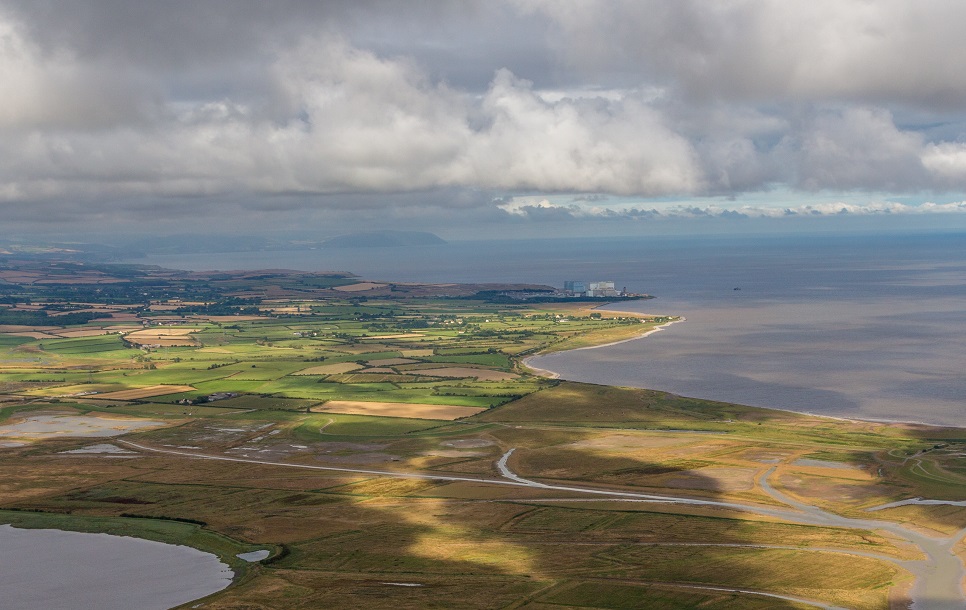Giant plughole poses serious threat to sea life in the UK's largest estuary
Up to half a million fish each day will be sucked into Hinkley Point C nuclear power station if it is allowed to install a “giant plughole” in one of the UK’s heaviest protected marine areas, the Severn Estuary.

Up to half a million fish each day will be sucked into Hinkley Point C nuclear power station if it is allowed to install a “giant plughole” in one of the UK’s heaviest protected marine areas, the Severn Estuary. It’s estimated at least half of those will be killed outright.
The extent of marine damage has emerged due to the plant’s owners, EDF, applying for permission to change the design of its cooling system which will draw water directly from the sea. Construction at Hinkley Point C has already begun on two tunnels in the seabed, each large enough to drive a double-decker bus through, which will suck in the equivalent weight in seawater of a dozen buses every second, and all sea life within it.
If permitted, it will give a green light to the nuclear power industry to kill millions more fish in UK waters in order to draw seawater to cool reactors, including at Sizewell in Suffolk and potentially Bradwell in Essex.
Although a mesh will stop larger fish being sucked into the Hinkley Point C itself, this serves only to protect the machinery. Many fish will die either pressed against the mesh, or in the system of buckets and chutes which will return injured fish, along with the dead, back to sea.
It’s feared the tunnels could cause extinction of the Twaite Shad in the UK – a fish which used to spawn in the Severn Estuary by the millions but whose population there is now down to the tens of thousands.)
EDF had received permission in 2013 to construct the system, on the promise of installing Acoustic Fish Deterrent (AFD) speakers which would keep up to 90% of specialist hearing fish away from the intakes. However this has proved too costly and impractical a promise to keep.
But rather than evaluating other methods to cool the power plant, EDF has instead reduced its original estimates of fish losses to now suggest the AFD speakers wouldn’t make much difference after all, so that construction might continue without them.
A number of environmental organisations say those figures “grossly underestimate” fish losses. They are urging the Environment Agency to reject EDF’s application to remove the AFD speakers and, if marine damage is too high without them, to insist that other cooling methods are explored instead.
The ball is now in the Environment Agency’s court to decide whether to accept EDF’s application, and to overrule its own original permitting decision which had placed a “high dependency on the proposed mitigation measures” including the AFD speakers. Its public consultation on the issue closes on 26 July.
Read WWT's full response to the consultation here.
Wildfowl & Wetlands Trust Director of Conservation James Robinson said:
“This is a landmark moment for the UK’s energy and its environment. The authorities must decide if it’s worth building a giant plughole to suck millions of sea animals to their deaths, in one of our most important protected marine areas, in order to produce electricity? The obvious answer is that alternatives exist and are used elsewhere - so if they accept this cheapest and most damaging option, the UK will be a global environmental embarrassment. We think it’s time for a rethink.”
Blue Marine Foundation Executive Director Charles Clover said:
“The Severn Estuary is an important nursery area and is meant to be protected in law from the sort of destruction proposed by direct cooling. We are looking into all legal means to protect the Severn and to make sure that similar proposals in Sizewell do not see the light of day. There are other, more sensible, ways of cooling power stations.”
Severn Rivers Trust Chief Executive Mike Morris said:
“The impact of Hinkley Point C will have a major impact on the wide variety of fish species resident in and migrating through the Severn Estuary. There is a large amount of work being undertaken in the rivers flowing into the Estuary and Bristol Channel by Rivers Trusts and partners from the south west of England to the Welsh mountains, including the £22m Unlocking the Severn project looking to open the UK’s longest river for all species of fish such as twaite shad, Atlantic salmon and European eels. The impact of Hinkley Point C will be completely counterproductive of the efforts of a large number of organisations to protect and restore our fish populations”.
Angling Trust Head of Campaigns Stuart Singleton-White said:
“We have serious doubts around the figures EDF are quoting in terms of fish kills if the AFD is removed and this outmoded direct cooling system built. The impacts have been grossly understated. Both because the area against which the level of fish kills are assessed, e.g. how many fish will be killed compared to a population geography covering the whole of the Celtic Sea, ignores the impact on more local Bristol Channel populations, and because proper account hsd not been given to the range of species that will be sucked into this plug hole. Many, such as Twaite Shad, Salmon and Eel, many be small in number, but as species increasingly under threat or endangered the loss of just a few individuals will have a massive impact. The level of fish kill we estimate will have a devastating impact on local recreational and sport fishing. This brings millions into the economy of the South West and is important for local employment. EDF are putting the viability of this vital sector at risk.”
Somerset Wildlife Trust Director of Conservation Michele Bowe said:
“The degree of uncertainty around the evidence on potential fish kill should be acknowledged by EDF. Without clarity on the impacts on fish populations and the wider ecosystem health of one of England’s most highly protected estuaries, we believe EDF must adopt a more precautionary approach. It is of grave concern that EDF is seeking to cancel one third of the measures originally imposed to protect fish numbers when construction work of the tunnel systems is well underway.”
Bristol Channel Federation of Sea Anglers President John May said:
“Over the last 15 years we have seen a dramatic fall in numbers of fish in the Upper Bristol Channel. In particular the numbers of small and immature fish /shrimps that were plentiful along our beaches have plummeted. Resident fish stock that were always plentiful [flounder, silver eels, whiting, pouting etc.] are few and far between. The information now available, past and future, on the Hinkley fish kill reveals the reason why. The EA should not renew the permit until EDF can provide a system that offers additional protection to the marine life in what is classified by the UK and Europe as an important marine protected area noted in particular for its diversified population of young fish. The problems with the Acoustic Fish Deterrent were known in 2012 and raised by us as anglers. The issues of tide and flow have not changed so why has it taken six years to bring this up - after construction is well under way?”
(Each of the above organisations is acting independently but have come together to help people understand one single story of what is at stake. Each is clear they are commenting purely on the cooling system’s impact on the Severn Estuary, and not in any way on the construction of Hinkley Point C per se, or nuclear energy more widely)
Deep dive into the fish loss calculations
EDF has published estimates of fish losses but all the environment organisations are wary of the findings, including that:
- EDF’s fish kill estimates have been largely extrapolated from a similar smaller system at Hinkley Point B. But there are concerns the calculations could be unsafe because they do not correctly take into account the mesh size and additional suction pull at Hinkley Point C, and because unrealistically large reductions were made to the estimates to account for tide movements and tunnel intake design.
- EDF has calculated percentage losses, not on the fish population in the Severn Estuary, but on much larger populations which can artificially reduce the figure. For some species, the base figure has been taken from populations from across the North East Atlantic, Celtic Seas and North Sea. Recent research (by the Inshore Fisheries and Conservation Authority) is suggesting that the estuary provides vital and unique habitat for resident fish populations.
- There has been inadequate peer review of the fisheries science used to base decisions on and a lack of acceptance of uncertainty, with no evidence of a precautionary approach.
The organisations are also wary of EDF’s suggestion that <1% losses of any species is acceptable – Twaite Shad for example have declined dramatically and this could accelerate losses.



